Risk Factors of Myopia Among Students: A Case Study in Selected Garrison Junior High Schools in The Greater Accra Region
Bernice Amoah-Ayisi K* and Stephen Manortey
Ensign College of Public Health, Kpong, Eastern Region, Ghana
Submission: November 10, 2021;Published: April 27, 2022
*Corresponding author: Bernice K Amoah-Ayize, Ensign College of Public Health, P.O. Box 136, Akosombo, (E/R), Ghana
How to cite this article: Bernice Amoah-Ayisi K, Stephen M. Risk Factors of Myopia Among Students: A Case Study in Selected Garrison Junior High Schools in The Greater Accra Region. JOJ Ophthalmol. 2022; 9(2): 555758. DOI: 10.19080/JOJO.2022.09.555758
Abstract
Background: Myopia (short-sightedness) is recognized as significant global health and socioeconomic problem that will affect billions of people in the subsequent decades. The increasing prevalence of myopia has huge social and educational consequences on society. Myopia exists expansively among students and affects not only their physical health and academic work, but also predisposes them to other ocular complications such as myopic retinopathy, glaucoma, and blindness. The main objective of this study was to determine risk factors associated with myopia among selected Garrison Junior High School students in the Greater Accra Region of Ghana.
Methodology: This was a cross-sectional quantitative study of students attending selected Garrison Junior High Schools in Accra, Ghana. Questionnaires were administered to the respondents and non-cycloplegic refraction was carried out for those who failed the visual acuity test using the Snellen’s Chart. Myopia in this study was defined as a spherical error of less than 0.50 D in one eye.
Results: The findings from this study revealed the prevalence of myopia to be 18.69% among the Garrison Junior High Schools students. Engaging in personal studies of more than two (2) hours daily outside school puts an individual at 4.25 increased odds of developing myopia compared to those who engaged in less than two (2) hours daily. Also, performing more than an hour of outdoor leisure activity daily is associated with 0.51 decreased odds of developing myopia compared to those who engaged in less than an hour of outdoor leisure activities daily.
Conclusion: It was observed that long hours spent on outdoor leisure/sports activities and long hours spent on personal studies were significantly associated with a lower and higher risk of developing myopia respectively among 5-Garrison Junior High School students.
Keywords: Myopia; Prevalence; Risk; Garrison Schools; Ghana
Introduction
Myopia (commonly called short-sightedness) is a refractive status of the eye in which parallel rays of light from a distant object focus in front of the retina with relaxed visual accommodation. This means that the eye is unable to refract light properly due to an overly curved cornea or the eyeball being too long from front to back. This results in the blurriness of distant objects that improve as the objects are brought closer to the eyes hence, the common name short-sightedness [1]. Unfortunately, this vision condition is recognized as a significant global public health and socioeconomic problem that will affect billions of people in the subsequent decades. Myopia is a serious public health problem that the world is currently battling with, which contributes to most visual impairments among people when left untreated. Knowledge about the risk factors of this type of refractive error in Ghana is very scanty and, in some instances, completely missing, hence myopia is an increasingly serious ocular problem that mostly goes undiagnosed and untreated among students who have it and later becomes a problem in adulthood. The problem of myopia among school children in Ghana is usually identified when they have trouble seeing on the blackboard or whiteboard from wherever they are seated in class, resulting in poor academic performance. Therefore, it is sometimes during investigations by parents and teachers to determine the cause of the child’s poor academic performance that this eye condition is detected. And even with this detection, it is mostly not addressed with the seriousness and urgency required [2]. The primary objective of this study is to determine potential risk factors associated with myopia among selected 5-Garrison Junior High School students in the Greater Accra Region of Ghana.
Methodology
Research Method and Design
The study adopted a cross-sectional quantitative study design guided using a standardized questionnaire modified from the Sydney Myopia Study Questionnaire [3], Snellen’s test and noncycloplegic refraction in the collection of data which helped to determine the prevalence as well as the contributing risk factors associated with the occurrence of myopia among the Junior High School students of the 5-Garrison Schools, Greater Accra Region of Ghana.
Sampling and Sample Size
Out of the 24 schools under 5-Garrison, 4 schools were selected by the Simple Random Sampling method. Students were selected from these schools by the Systematic Sampling method. The sample size was calculated using Cochran’s formula [4] shown below:

Where,
n = sample size
p = prevalence of myopia (15%) from a previous study [5]
q = anticipated prevalence of absence of myopia is equal to 1-0.15=0.85
e = margin of error bound set at 5% (0.05)
Z = the standard Z score at 95% confidence interval, which is 1.96
Hence

A minimum sample size of 196 was calculated. With a 10% non-response rate, about 20 participants were added to the minimum sample size to get a sample size of 216 and this was rounded up to get 220 participants.
Clinical Examination
The standardized questionnaire was administered to the students privately before the vision test was carried out. Visual acuity (VA) was measured using the Snellen chart at 6 meters. Children who wear glasses had their visual acuity taken while they removed their glasses, and their lenses were neutralized to know the powers. Students who read 6/9 or worse were refracted. Non-cycloplegic refraction was carried out for all students who read 6/9 or worse with an improvement of vision with a pinhole on the Snellen chart. This method was employed in order not to disrupt academic work for the day. To ensure that accommodation was relaxed, a +1.50 D lens was used to fog the eye monocularly during refraction. Myopia for purposes of this study was defined as spherical error of at least -0.50diopters in one eye. The study was pre-tested in a private Junior High School in the La circuit of the La Dadekotopon Municipality to assess the adequacy of the research instruments and the feasibility of the study.
Data Analysis
Data analysis was done with the STATA statistical software package (StataCorp.2007. Stata Statistical Software. Release 14. Stata Corp LP, College Station, TX, USA). A baseline comparison of myopes and emmetropes was carried out to compare age, gender, number of hours spent engaging in near work, number of hours spent outdoors, 30 mins break during long study hours, parental myopia, and Highest Parental Educational Status. Results were expressed in tables as means, percentages, and frequencies. Bivariate and multivariate analyses were conducted to respectively test the level of association and predict the effects between the eye condition and selected demographic indicators. All data analyses were carried out at a 95% confidence interval and level of significance of p<0.05.
Ethical Considerations
Ethical approval for the study was obtained from the Ethical Review Committee of Ensign College of Public Health. Additionally, administrative permissions were sought and obtained from the La Dadekotopon Education Office and the Garrison Education Office. Heads, guardians, and respondents of the selected schools were briefed on the purpose and methodology to be used for the research. Assent forms were signed by students and were assured of the possibility to withdraw their assent at any time without suffering any consequences for doing so.
Results
Respondents’ Socio-demographic Characteristics
A fully completed data for 214 participants out of the 220 were available for analysis, thereby resulting in a 97.27% response rate. For the demographic characteristics of this study, out of the 214 students who were examined and interviewed, 117 were females and 97 were males, constituting 54.67% and 45.33% of the study population respectively. The distribution by age groupings also revealed 114 (53.27%) were in the 11-13 years group, 86 (40.19%) belonged to the 14-15 years group and 14 representing 6.54% of the sampled students were older than 15 years. Concerning the highest level of education attained by the respondents’ parents, 17 (7.94%) had their parents schooling up to the primary level, 81 (37.85%) students had their parents schooling up to the secondary/vocational school level and 116 (54.21%) had either or both their parents attaining a university degree. With regards to fathers’ occupation, all the fathers of the respondents were actively employed with 42.06% of them working as security personnel (soldier, police, immigration, and customs) or civilian employees in a security service installation. It was observed that 24.77% of the respondents had their fathers being civil servants/professionals, 16.82% reported their fathers’ occupation to be service/sales workers and 16.35% working in other occupations (Table 1).
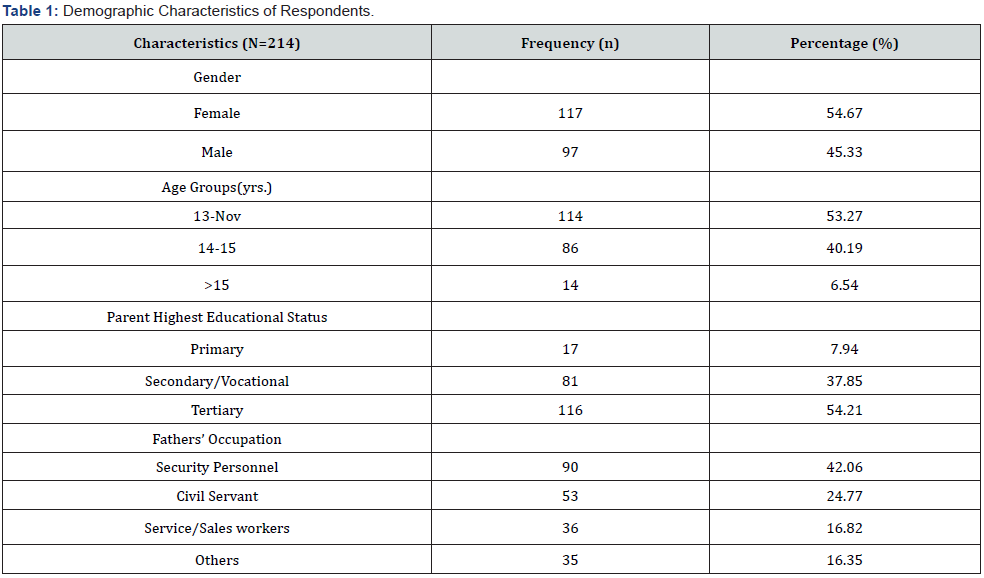
Prevalence of Myopia
Out of the 214 students sampled and examined, 40 were noted to be suffering from myopia, while the remaining (174) were nonmyopic at the time of enrolment into the study. The prevalence of myopia among the student was estimated to be 18.69% as shown in Table 2 below.

Measure of association between selected variables and examined eye condition
From the bivariate analysis Table 3 it was observed that 25 out of the 40 myopes, representing 62.50% were females whilst the remaining were males. A Pearson Chi-Square test of association yielded a test statistic of 1.22 with a p-value of 0.27. Indicating the lack of significant statistical difference between myopic and nonmyopic students relating to gender although there were relatively more female students suffering from myopia as compared to their male counterparts. A Chi-square test with a p-value of 0.76 shows that there was an insignificant difference between the nonmyopic and myopic groups with regards to age, although it could be drawn from the results that the younger students (11-13years) reported a higher prevalence of myopia (50.00%) compared to the older students (14 years and above). The prevalence of myopia decreased gradually in the higher age groups (45% and 5% respectively). The results illustrated that the prevalence was greater among myopic students whose parents wear glasses (70%) as a corrective measure for refractive error as compared to those whose parents do not wear glasses (30%) (Figure 1). The p-value for this test of association was less than 0.05 indicating that there is a statistically significant difference between the myopic and non-myopic groups with regards to students’ parent(s) wearing glasses. Also from this bivariate analysis, parents’ highest education level did not show any association with myopia in the children because its p-value (0.18) was greater than 0.05.
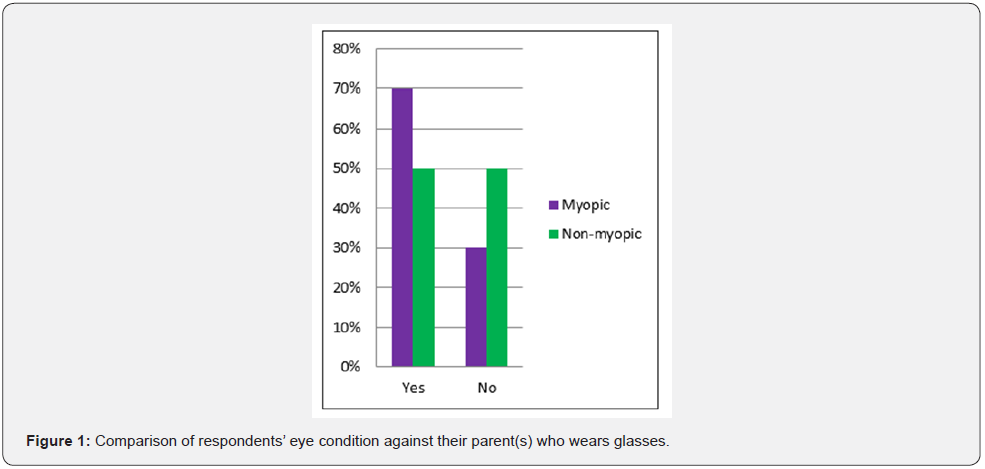
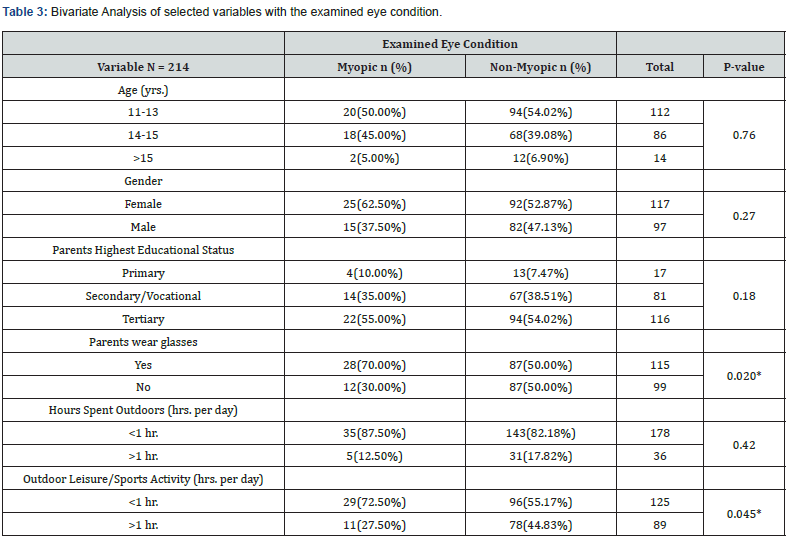
*Statistically significant at a 95% Confidence level.
Finally, daily hours spent on outdoor leisure or sporting activities showed a statistically significant difference between the myopic and the non-myopic groups since the p-value (0.045) is less than 0.05. Also, for this same variable, the prevalence of myopia among those who spend less than one hour engaging in outdoor activities is higher (72.50%) as compared to those who spend more than one hour (27.25%) engaging in those same outdoor activities Figure 2. However, there was no statistically significant association between hours spent outdoors in general and myopia because, from the analysis, the p-value was greater than 0.05.
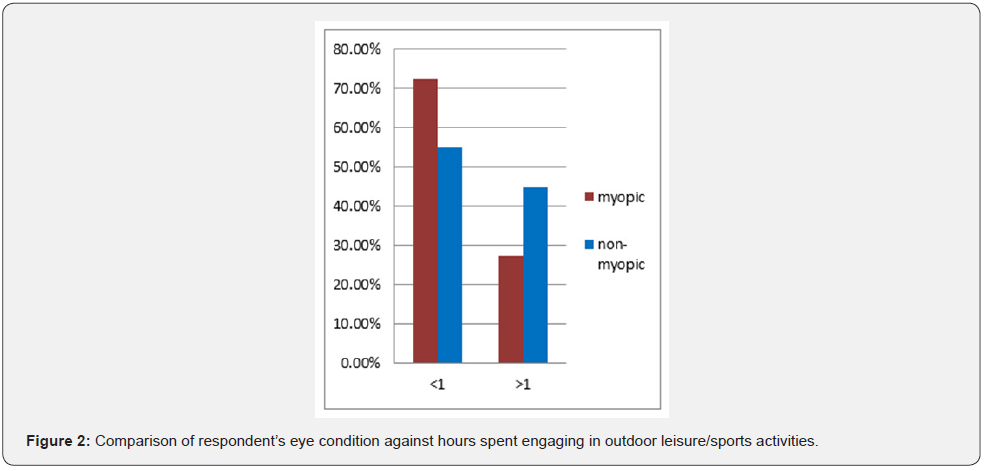
Measure of association between selected near-work activities and examined eye condition
All the other near work activities, that is, 30 minutes break during continuous reading, electronic gadgets’ use (hours per day), TV watching time, and indoor leisure activities were not statistically significant according to the Chi-square test for association because their respective p-values were greater than 0.05, except for personal studies outside school. From the results, it was also observed that among the myopic group, those who studied for more than two (2) hours per day outside school had a higher prevalence of myopia (82.50%) as compared to those who studied for less than two hours per day outside school (17.50%) (Table 4).
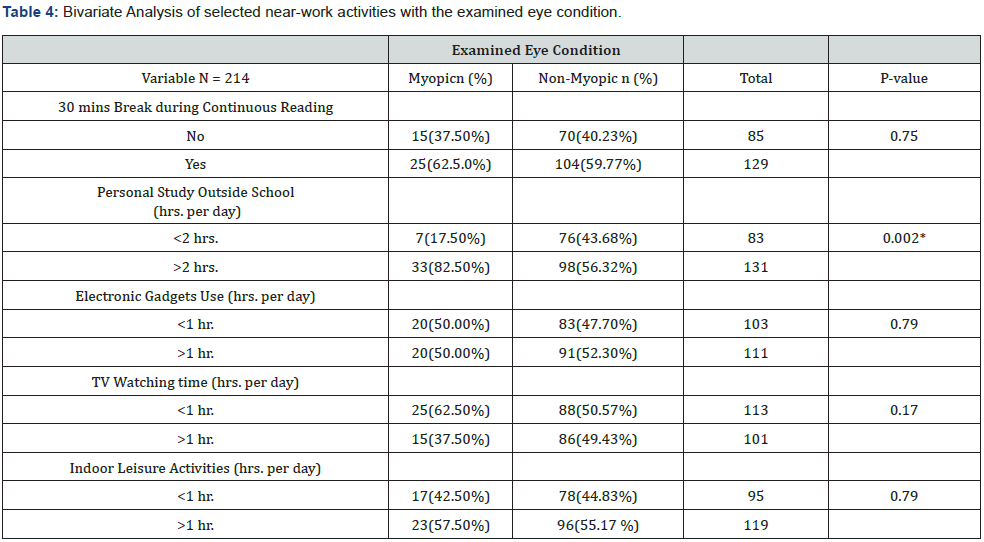
*Statistically significant at a 95% Confidence level.
Factors contributing to myopic eye condition among respondents

*C.I. = Confidence Interval.
Table 5 displays the crude and adjusted logistic regression analysis results with regards to the association between myopia and the factors studied. In the simple logistic regression, having at least a parent who wears glasses was a risk factor for developing myopia (OR=2.7133, 95% CI=1.11-4.88, P<.05) compared to having a parent who did not wear glasses, Having the habit of engaging in >2 hours of personal studies outside school also increased the odds of developing myopia (OR=3.66, 95% CI=1.53- 8.72, P<.05). Performing over 2 hours of outdoor leisure/sports activity per day was a protective factor against myopia (OR=0.47, 95% CI=0.22-0.99, P<.05). After adjustment for age and gender, it was revealed that having at least a parent who wears glasses and engaging in >2 hours daily of personal studies outside school were risk factors for developing myopia (AOR=2.71, 95% CI=1.19-6.19, P<.05 and AOR=4.25, 95% CI=1.69-10.66, P<.05 respectively). Also, performing more than 2 hours of outdoor leisure/sports activity per day was associated with less myopia after adjusting for all other variables (AOR=0.41, 95% CI=0.17- 0.94, P = 0.035).
Discussion
According to the 2018 WHO Report, myopia is considered one of the main public health problems worldwide [6]. This study sought to explore the prevalence of myopia among Junior High School students in 5-Garrison Schools in the Greater Accra Region of Ghana aged between 11 and 16 years. It was observed in this research that the prevalence of myopia was 18.69% among the school children that were sampled. This was much higher than the prevalence of myopia of 1.7% obtained in a study conducted among school children aged 11-18 years in Cape Coast Municipality, Ghana [7]. Since this study was also carried out in another part of Ghana, within a similar age group, and dates to 2010, this could imply that over the years, there has been a significant increase in the prevalence of myopia in the country. Gender in this study was not found to be significantly associated with myopia, that is, p=0.27, however, it was seen that the prevalence of myopia among females was higher as compared to their male counterparts. This is similar to results obtained by some studies like those conducted by [8,9] which showed that the prevalence in girls was significantly higher than that in boys within the age group of 9-16 years. This may be attributed to the differences in lifestyle choices and habits that predispose the females to develop myopia than that of the males.
With regards to age, from the bivariate analysis in this study, there was no significant association between age and myopia (p-value=0.76) and the prevalence of myopia among the age groups decreased as the ages increased. This contradicts a study carried out by Theophanous et al. [10] to evaluate the prevalence and risk factors for pediatric myopia in a contemporary American cohort. His study was carried out among pediatric patients aged 5-19 years old and he concluded that myopia was more common in older children compared to their younger counterparts which could be attributed to the fact that older students may be at a higher risk of suffering from myopia because of more exposure to environmental factors (especially more near-work activities) which hastens the progression of myopia. Also, older students may have more demanding work in a school which may require them to do more reading and writing which can increase the axial length of the eye and put them at greater risk of developing myopia [5].
In assessing the effect of near work on myopia development, according to [11], in a 3-year longitudinal study carried out among myopic students, the prevalence of myopia among students was significantly related to time spent on reading, but not with time spent playing with video display terminals. This finding agrees with that of our study with regards to time spent on electronic gadgets’ use and personal studies outside school. In our study, the results showed that there is a causal association between myopia and hours spent on personal studies outside school but there was no association between myopia and time spent using electronic gadgets as well as time spent engaging in indoor leisure activities. It could be possible, as an explanation to the above findings, that children predisposed to the development of myopia enjoy activities that utilize close vision such as reading and studying. This is because it has long been hypothesized that accommodation from near-work activities and the accompanying change in lens shape increases vitreous chamber pressure in the eye, leading to axial elongation and eventually myopia [12].
Studies in Australia, China, and Ireland reported similar results, where more hours spent on outdoor activities were found to reduce the prevalence of myopia. These studies agree with the results obtained in this study as it was also observed that engaging in > 1-hour outdoor sports/leisure activity per day reduced the risk of developing myopia by 0.59 as compared to engaging in < 1-hour outdoor sports/leisure activities daily after all the variables in the study had been adjusted for. Several studies hypothesized that the protective effect of spending time outdoors seems to be associated with exposure to sunshine, which was also in line with our study. Similarly, animal experiments revealed the most consistent mechanism underlying the association between times spent outdoors and myopia is the light levels associated with outdoors. The apparent protective effect of sunlight on myopia could be because of indirect chemical interactions associated with light, such as vitamin D [13], or dopamine moderation [14,15]. From their analysis of both human and animal studies, [15] suggested that as light triggers dopamine production and release from retinal amacrine cells, it might then prevent the axial elongation of the eye that causes myopia to develop.
Conclusion
The findings from this study present a rough impression of the prevalence of myopia to be 18.69% among Junior High School students within the selected 5-Garrison School structure in the Greater Accra Region of Ghana. Engaging in personal studies for more than 2 hours daily outside school can put an individual at 4.25 increased odds of developing myopia compared to those who engaged in less than 2 hours of personal studies daily outside school adjusting for all other predictors. Also, performing more than 1 hour of outdoor leisure/sports activity per day was associated with 0.59 decreased odds of developing myopia as compared to those who engaged in less than 1 hour of outdoor sports/leisure activities daily, making it a protective factor. The study concludes that longer time spent on outdoor leisure/sports activities and long hours spent on personal studies were significantly associated with a lower and higher risk of developing myopia respectively. This study has valuable implications for myopia prevention and control among students in Accra, Ghana since these associations may indicate that low intensity near work (time spent on personal studies) and more time spent outdoors engaging in leisure/sports activities are important for developing interventions to address the occurrence of myopia among schoolchildren.
Acknowledgement
The authors express their sincere thanks to the staff of 37 Military Hospital (Optometry Department), Ghana Armed Forces Headquarters (Medical) and 5-Garrison Education Office as well as teachers and students of the 5-Garrison Junior High Schools for their immense support.
References
- Koomson N, Lartey S, Adjah K (2013) Prevalence of Myopia amongst patients with refractive error in the Kumasi Metropolis of Ghana. Journal of Science and Technology (Ghana) 33(2): 73
- Kumah DB, Aggrey NJ, Afoakwah P, Nelson-AD, Ankamah E (2016) Prevalence of Myopia among Senior High School Students in the Kumasi Metropolis. JOJ Ophthalmology 1(4): 1-5.
- Giloyan A, Harutyunyan T, Petrosyan V (2017) Risk Factors for Developing Myopia among Schoolchildren in Yerevan and Gegharkunik Province, Armenia, Ophthalmic Epidemiology 24(2): 97-103.
- Cochran WC (1977) Snedecor GW & Cochran WG Statistical methods applied to experiments in agriculture and biology. 5th edn. Ames, Iowa: Iowa State University Press, 1956 Citation Classics 19(19): 1.
- Boaitey O (2015) Prevalence and risk factors of myopia. A case study of senior high school students in Sekyere East district of Ghana.
- World Health Organization (2018) The Impact of Myopia and High Myopia, World Health Organization, Geneva.
- Ovenseri-Ogbomo GO, Assien R (2010) Refractive error in school children in Agona Swedru, Ghana, African Vision, and Eye Health 69(2): 86-92.
- Czepita M, Safranow K (2019) Role of gender in the prevalence of myopia among polish schoolchildren. Journal of Ophthalmology 1-4.
- Xie Z, Long Y, Wang J, Li Q, Zhang Q (2020) Prevalence of myopia and associated risk factors among primary students in Chongqing: Multilevel modeling. BMC Ophthalmology 20: 1-8.
- Theophanous C, Modjtahedi BS, Batech M, Marlin DS, Luong TQ, et al. (2018) Myopia prevalence and risk factors in children. Clinical Ophthalmology 12: 1581-1587.
- Pärssinen O, Kauppinen M, and Viljanen A (2014), The progression of myopia from its onset at age 8-12 to adulthood and the influence of heredity and external factors on myopic progression. Acta Ophthalmologica 92(8): 730-739.
- Li L, Zhong H, Li J, Li C, Pan C (2018) Incidence of myopia and biometric characteristics of pre-myopic eyes among Chinese children and adolescents, BMC Ophthalmology 18: 1-8.
- Mutti D O (2014) Vitamin D may reduce the prevalence of myopia in Korean adolescents. Invest Ophthalmol Vis Sci 55(4): 2048.
- Feldkaemper M, Schaeffel F (2013) An updated view on the role of dopamine in myopia. Experimental Eye Research Journal 114: 106-119.
- Norton T, Siegwart J (2013) Light levels, refractive development, and myopia- a speculative review. Experimental Eye Research Journal 114: 48-57.






























